International Hotel (San Francisco)
|
International Hotel | |
|
The 2nd incarnation of the International Hotel | |
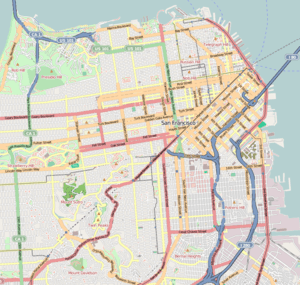 | |
| Location | San Francisco, California |
|---|---|
| Coordinates | 37°47′46″N 122°24′17″W / 37.7961°N 122.4048°WCoordinates: 37°47′46″N 122°24′17″W / 37.7961°N 122.4048°W |
| Built | Original built 1907, current built 2005 |
| Architect | Unknown |
| Architectural style | Contemporary |
| NRHP Reference # | 77000333 |
| Added to NRHP | June 15, 1977 |
The International Hotel, often referred to locally as the I-Hotel and intended as a luxury destination for wealthy travelers, was originally built on Jackson Street in 1854, moved to its 848 Kearny Street location in 1873 and was rebuilt in 1907 after the great San Francisco earthquake and fire in 1906. By the 1920s, the International Hotel found itself squarely in the middle of a 10-block Filipino American enclave along Kearny Street known as Manilatown, the Manilatown section of San Francisco and became a low-cost residential hotel. During the 1920s and 1930s, thousands of seasonal Asian laborers came to reside at the hotel.[1] It was home to many Asian Americans, specifically a large Filipino American population. Around 1954, the I-Hotel also famously housed in its basement Enrico Banduccci's original "hungry i" nightclub. By the late 1970s, the I-Hotel was almost all that was left of Manilatown. The hotel was demolished in 1981, and after the site was purchased by the International Hotel Senior Housing Inc., it was rebuilt and opened in 2005. It now shares spaces with St. Mary's School and Manilatown.
History
"Urban Renewal" planning
The primarily Filipino population of immigrants living at the I-Hotel represented an area of Kearny Street in Chinatown known as San Francisco's Manilatown. Despite its full occupancy, during the urban renewal and redevelopment movement of the mid-1960s, the International Hotel was targeted for demolition. This "urban renewal" that was occurring in response to the ending of World War II had destroyed the heart of this section of San Francisco—The Fillmore District, west of downtown, hundreds of homes and thousands of residents were displaced due to the city's plans to expand the downtown business sector.[2]
Eviction opposition
Along with the ten full blocks of low-cost housing, restaurants, barber shops, markets, clubs and other businesses that benefited the Filipino community of around 10,000 people being destroyed, the International Hotel was planned to be demolished next. In order for the city to demolish the building, they needed to evict all of the "old timers" that lived in the I-hotel.[1] Due to the 50 dollars a month rent, many of the tenants were poor and the community that was based around this residence was all that they had. There were 196 tenants in the building that were ordered to leave in October of that same year.
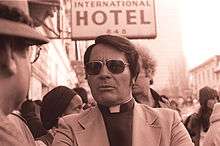

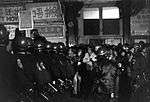
For years after the first eviction notices were served in 1968, many individuals were involved in the long fight that took place on the streets, in courtrooms, and in the everyday lives of the I-Hotel Manilatown residents. Some community characters involved in the struggle were Al Robles, Filipino-American San Francisco Poet, and at one point, controversial Peoples Temple leader Jim Jones. After Jones was appointed as Chairman of the San Francisco Housing Authority Commission, the Housing Authority voted to acquire the building using $1.3 million in federal funds and then to turn it over to tenants rights groups.[3] When a court rejected that plan and ordered evictions in January 1977, the Peoples Temple provided two thousand of the five thousand people that surrounded the building, barricaded the doors and chanted "No, no, no evictions!"[3] Sheriff Richard Hongisto, a political ally of Jones, refused to execute the eviction order, which resulted in Hongisto being held in contempt and serving five days in his own jail.[3]



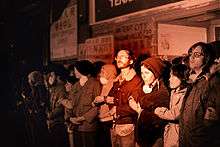

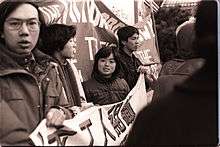

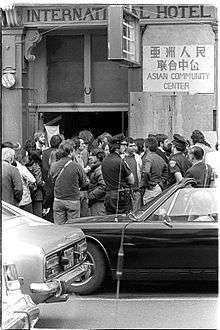

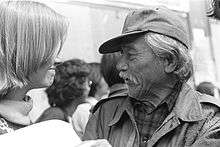

The final residents were evicted on August 4, 1977. In 1978, then-Mayor Dianne Feinstein created an International Hotel Citizens Advisory Committee, which was unable to break the deadlock between low-cost housing advocates and the property owner. The building stood empty while the fate of the site continued to be debated, but was finally demolished in 1981.
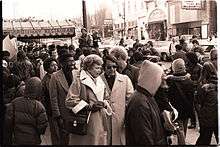

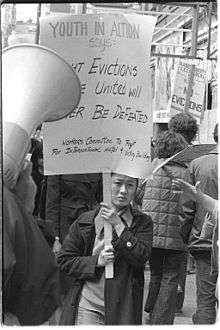
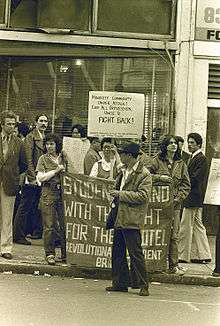
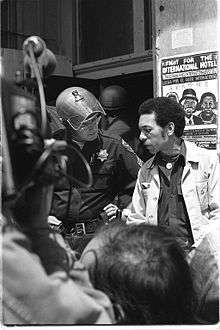


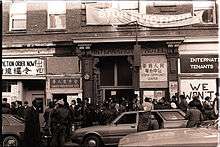

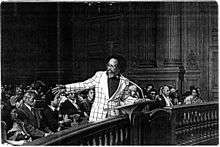
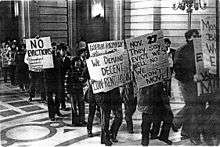
International Hotel Manilatown Center
In 1994 the site was acquired by the Roman Catholic Archdiocese of San Francisco.[4] The air rights were later sold to Chinatown Community Development Center which planned to build a replacement low-cost residential project. In 2003, construction began on the new I-Hotel, and the building was completed on August 26, 2005. The new building contains 105 apartments of senior housing. A lottery was held to determine priority for occupancy, with the two remaining living residents of the original I-Hotel given priority. Occupancy started in October 2005, and the new building also contains a ground-floor community center and a historical display commemorating the original I-Hotel.
Chan Is Missing
The hotel and its elderly Filipino tenants were in a scene in the 1982 indie film Chan Is Missing by Wayne Wang (director of The Joy Luck Club).[5]
"The Fall of the I-Hotel"
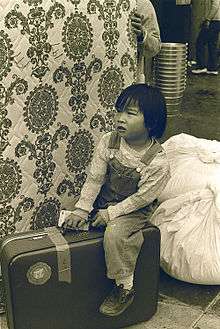

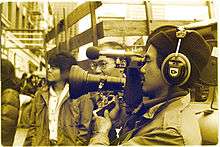
The documentary "The Fall of the I-Hotel" was made in 1983 and updated in 2005. Curtis Choy wrote and directed the piece, which was narrated by Filipino poet and housing activist Al Robles. The documentary shows the eviction of tenants of the hotel and its demolition.

See also
| Wikimedia Commons has media related to International Hotel (San Francisco). |
References
- 1 2 Salomon, Larry R (1998). Roots of justice: stories of organizing in communities of color. Chardon Press. p. 160. ISBN 978-1-890759-02-5.
- ↑ http://www.nhi.org/online/issues/107/organize.html. Missing or empty
|title=(help) - 1 2 3 Reiterman, Tim, and John Jacobs. Raven: The Untold Story of Rev. Jim Jones and His People. Dutton, 1982. ISBN 0-525-24136-1. page 282–3.
- ↑ The I-Hotel rises again, San Francisco Chronicle, July 22, 2005
- ↑ Wang, Wayne (Dir.) (1982). Chan Is Missing (DVD). New York: Koch Lorber Films. Event occurs at 14:15.
- Estrella, Cicero A. (July 28, 2004). "'Manilatown' will rise again: 2 blocks of Kearny designated to honor Filipino immigrants". San Francisco Chronicle. Retrieved 2006-12-03.
- Pangilinan, Erin (August 17, 2005). "The rebirth of I-Hotel". Philippine News Online. Archived from the original on 2006-10-18. Retrieved 2006-12-03.
- Pangilinan, Erin (August 31, 2005). "Historic hotel rises from rubble". Philippine News Online. Archived from the original on 2006-10-18. Retrieved 2006-12-03.
Further reading
- Habal, Estella (2007). San Francisco's International Hotel: mobilizing the Filipino American community in the anti-eviction movement. Philadelphia, Pennsylvania: Temple University Press. p. 227. ISBN 978-1-59213-445-8.
- Shaw, Randy (1998). "Tenant Power in San Francisco". In Brook, James; Carlsson, Chris; Peters, Nancy J. Reclaiming San Francisco: History, Politics, Culture. A City Lights anthology. City Lights Books. pp. 287–300. ISBN 9780872863354.
External links
- https://www.flickr.com/photos/tags/ihotel/ User photographs documenting 30+ years of I-Hotel and its residents
- Manilatown Heritage Foundation, currently on the site of I-Hotel
- The Fall of the I-Hotel, documentary (1983, 2005)
- International Hotel SFGTV San Francisco APA Heritage Month, SFGTV (May 2007)
- International Hotel at the Digital Archaeological Record